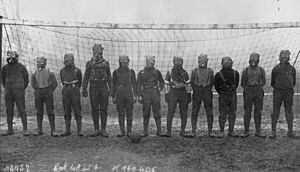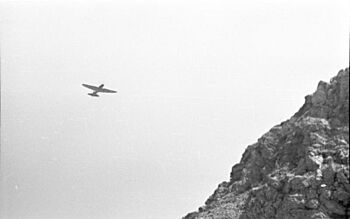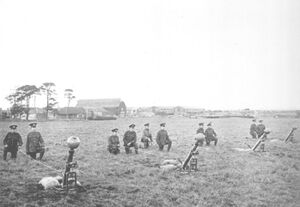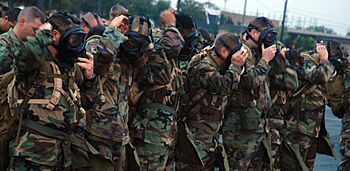History of chemical warfare facts for kids
Chemical weapons have been used in wars for a very long time, even centuries ago. However, their use became extremely controversial and debated starting in the 1900s.
Contents
- Early Uses of Chemical Weapons
- Chemical Warfare in Early Modern Times
- The Industrial Age and New Chemical Weapons
- Chemical Weapons in World War I
- Between the World Wars
- Chemical Weapons in World War II
- Chemical Weapons During the Cold War
- Chemical Weapons in Recent Conflicts
- Chemical Weapons and Terrorism
- Treaties Against Chemical Weapons
Early Uses of Chemical Weapons
People have thought about using toxic weapons for a long time. Ancient Greek stories mention the hero Heracles dipping his arrows in monster venom. Even in the famous epics Iliad and Odyssey, there are mentions of poisoned arrows during the Trojan War.
In ancient India, old writings like the Ramayana and Mahabharata talk about toxic warfare. The "Laws of Manu" (around 400 BC) said not to use poison or fire arrows, but it did suggest poisoning food and water. Another book, "Arthashastra", had many recipes for poison weapons and toxic smokes. Greek historians wrote that Alexander the Great saw poison arrows and fire weapons in India around 300 BC.
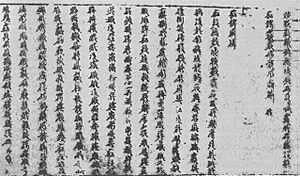
The Chinese knew about smokes containing arsenic as early as 1000 BC. Sun Tzu's "Art of War" (around 200 BC) suggested using fire weapons. Later Chinese writings described using bellows to pump smoke from burning toxic plants into enemy tunnels during sieges. They also had recipes for poisonous smokes and accounts of using "soul-hunting fog" and lime powder to stop a peasant revolt.
The first recorded use of gas warfare in the West was during the Peloponnesian War (around 400 BC) between Athens and Sparta. Spartan soldiers tried to smoke out Athenians by burning wood, pitch, and sulfur under city walls. Another story says Solon of Athens poisoned a water supply with hellebore roots during a siege around 590 BC.
Scientists found the earliest physical proof of gas warfare during the Roman–Persian wars. In a collapsed tunnel at Dura-Europos in Syria, it seems the Sasanians burned bitumen and sulfur crystals. This created choking sulfur dioxide gas, which killed 19 Roman soldiers very quickly.
In the Middle Ages, quicklime (a type of calcium oxide) might have been used in naval battles. Historian David Hume wrote that in the 1200s, the English Navy blinded a French fleet by throwing quicklime at them.
When Spanish explorers arrived in Hispaniola in the late 1400s, the Taíno used a simple chemical weapon. They threw gourds filled with ashes and ground hot peppers to create a blinding smoke screen before attacking. Natives in Brazil also used pepper smoke during sieges, lighting bonfires with peppers when the wind blew towards the enemy.
Chemical Warfare in Early Modern Times

In the 1400s, Leonardo da Vinci suggested using a powder made of sulfide, arsenic, and verdigris against enemy ships. He thought it would make people choke. We don't know if this was ever used.
During the 1600s, armies used shells filled with things like sulfur, tallow, and saltpeter to start fires during sieges. Even if fires didn't start, the smoke and fumes were a big distraction.
In 1672, Christoph Bernhard von Galen, the Bishop of Münster, tried to use explosive devices with belladonna to create toxic fumes during the siege of Groningen. Just three years later, France and the Holy Roman Empire signed the Strasbourg Agreement, which banned "perfidious and odious" toxic devices.
Pirate Captain Thompson used "stinkpots" filled with powder and grenades to defeat pirate-hunters in 1721. The Qing dynasty in China also used "stinkpots" in naval battles. These earthenware pots were filled with sulfur, gunpowder, and other smelly materials to create unpleasant and suffocating smoke when lit. Stinkpots were even used by the British Navy in the War of 1812.
The Industrial Age and New Chemical Weapons
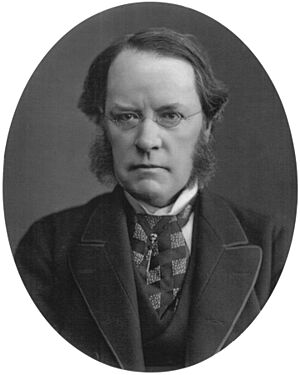
The idea of modern chemical warfare really began in the mid-1800s with new developments in chemistry. The first modern suggestion for chemical warfare came from Lyon Playfair in 1854 during the Crimean War. He suggested using cyanide artillery shells against enemy ships. The British government rejected this idea, saying it was "as bad a mode of warfare as poisoning the wells." Playfair argued that war is about destruction, and if a poisonous vapor could kill without suffering, it should be allowed.
During the American Civil War, a teacher named John Doughty suggested using chlorine gas in artillery shells. His idea was never put into action.
In 1868, during the Paraguayan War, Paraguayan troops threw lit tubes with suffocating mixtures at Brazilian ships. The attack failed.
By 1899, there was growing concern about poison gas. At the Hague Conference, a proposal to ban shells filled with asphyxiating gas was passed. Only the United States voted against it, saying American inventiveness shouldn't be limited in developing new weapons.
Chemical Weapons in World War I
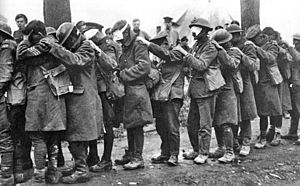
World War I saw the first widespread use of chemical weapons. France was the first to use tear gases in 1914. Germany then used irritant chemicals in shells.
The first large-scale use of deadly chemical warfare agents was on April 22, 1915, at the Second Battle of Ypres. German forces released chlorine gas from canisters, letting the wind carry it towards French, Canadian, and Algerian troops.
Both sides used a total of over 50,000 tons of gases like chlorine, phosgene, and mustard gas. About 1.3 million people were hurt by chemical weapons during the war. An estimated 100,000 to 260,000 of these were civilians. Nearby towns were at risk from the wind blowing the gases. Civilians often didn't have warning systems or effective gas masks.
Even today, unexploded chemical ammunition from World War I is still found in places like Belgium and France. After the war, many chemical weapons were dumped into the sea. For example, about 65,000 tons were dumped in the Baltic Sea. Over time, the containers rust, and the chemicals leak out. Mustard gas can form waxy lumps that wash ashore, which are very toxic.
Between the World Wars
After World War I, chemical agents were sometimes used to control populations or stop rebellions. In 1925, 16 major nations signed the Geneva Protocol. This agreement promised not to use chemical weapons in wars between countries. The United States signed it but didn't officially approve it until 1975. The Protocol didn't ban making or storing chemical weapons, and it didn't apply to conflicts within a country.
Chemical Use by Different Nations
Some historians claim the British used chemical weapons in Mesopotamia (modern-day Iraq) during a revolt in 1920. Winston Churchill was said to be in favor of using "poisoned gas against uncivilised tribes." However, other historians say the weapons were planned but not actually used.
Lenin's Soviet government used poison gas in 1921 during the Tambov Rebellion. An order stated that forests where rebels were hiding should be "cleared by the use of poison gas." In the 1930s, the Soviet Union also used mustard gas dropped from planes against rebels in Central Asia and against Chinese forces in 1934.
During China's Warlord Era, some warlords tried to get or make chemical weapons. One warlord, Zhang Zuolin, built a chemical plant to produce chlorine, phosgene, and mustard gas. There was one report of his aircraft dropping "gas bombs" on enemy forces.
Spanish and French forces dropped mustard gas bombs on Berber rebels and civilians during the Rif War in Spanish Morocco (1921–1927). These were the first widespread uses of gas warfare after WWI. Spain used gases like phosgene and mustard gas against civilians, markets, and rivers. Even though Spain signed the Geneva Protocol in 1925, it only banned chemical weapons in international conflicts, not internal ones like the Rif War.
Italy also used mustard gas and other harsh methods against forces in Libya as early as 1928. From 1935, Fascist Italy used mustard gas against Ethiopians during the Second Italo-Abyssinian War, which was against the Geneva Protocol. Benito Mussolini personally approved the use of chemical weapons. They were dropped from planes "on a massive scale against civilians and troops," and to contaminate fields and water. Some estimate that up to one-third of Ethiopian casualties were caused by chemical weapons.
After World War II, the Italian government denied using chemical weapons in Africa. It wasn't until 1995 that Italy officially admitted it.
The Discovery of Nerve Agents
After World War I, Germany worked hard to regain its lead in chemical warfare. In the 1920s, Germany and the Soviet Union collaborated on poison gas research.
Chemical warfare changed completely with Nazi Germany's discovery of nerve agents like tabun (in 1937) and sarin (in 1939). These were found by chemist Gerhard Schrader. Another nerve agent, soman, was discovered in 1944. Germany developed and made large amounts of these agents, but they were not widely used in combat.
Chemical Weapons in World War II
Japan's Use of Chemical Weapons
Despite international agreements banning chemical weapons, the Imperial Japanese Army often used them. They were mostly used against Chinese troops and guerrillas, not against Westerners, due to fear of retaliation. Historians say that gas weapons, like tear gas, were used from 1937, and then sneeze, nausea, and mustard gas were used from 1938.
These chemical weapon uses were authorized by Emperor Hirohito himself. For example, he approved toxic gas use 375 times during the Battle of Wuhan in 1938. The Japanese also experimented with chemical weapons on live prisoners. Australia even secretly imported chemical weapons from the UK during the war, planning to use them if Japan used chemical weapons first.
Nazi Germany's Chemical Weapons
During the Holocaust, Nazi Germany used carbon monoxide and hydrogen cyanide (like Zyklon B) to kill millions of Jews and other victims. This was the deadliest use of poison gas in history. However, the Nazis did not use chemical weapons widely in combat, especially not against the Western Allies. They had an active chemical weapons program and even experimented on concentration camp prisoners with nerve gas.
Historians believe the Nazis avoided using chemical weapons in battle because they feared the Allies would use their own chemical weapons in return. Also, Adolf Hitler himself had been gassed in World War I, which might have influenced his decision. Hitler ordered nerve gas production to be doubled but feared a rogue officer might use them and trigger Allied retaliation.
The Nazis did use chemical weapons in combat a few times along the Black Sea. For example, in Sevastopol, they used toxic smoke to force Soviet fighters out of caves. They also used asphyxiating gas in the catacombs of Odessa in 1941 and during the Battle of the Kerch Peninsula in 1942, killing thousands of Soviet defenders.
Western Allies and Chemical Weapons

The Western Allies did not use chemical weapons during World War II. The British planned to use mustard gas and phosgene to defend against a German invasion in 1940-1941. Winston Churchill, the British Prime Minister, even considered a chemical strike on German cities. However, military advisors warned that this would cause Germany to retaliate with gas, which would harm the Allies.
The U.S. Army developed chemical warfare rockets filled with cyanogen chloride (CK), a deadly agent that could get through some gas masks. These were intended for use against Japanese forces, especially those hiding in caves. However, these CK rockets were never actually used in combat.
Accidental Release of Chemical Weapons
On December 2, 1943, German bombers attacked the port of Bari in Italy. They sank several American ships, including the SS John Harvey, which was secretly carrying mustard gas. The presence of the gas was highly classified, so doctors didn't know what they were dealing with, leading to more deaths. About 69 deaths were linked to the mustard gas, mostly American merchant seamen. The incident was kept secret for many years.
Chemical Weapons During the Cold War
After World War II, the Allies found German artillery shells with nerve agents (tabun, sarin, and soman). This led to more research into nerve agents by all the former Allies. During the Cold War, both the Soviet Union and Western governments spent huge amounts of money developing chemical and biological weapons.
Britain's Chemical Weapons Research
In the late 1940s and early 1950s, Britain's chemical weapons research was at Porton Down. They aimed to create modern nerve-agent weapons and ways to defend against them. A chemist discovered a new class of compounds that were too toxic for pesticides. These were developed into even deadlier nerve agents called V agents, like VX.
Tests were carried out on servicemen to see the effects of nerve agents on humans. One serviceman died in 1953 during a sarin nerve agent test. Britain stopped its offensive chemical weapons program in 1956.
United States Chemical Weapons Research
In 1952, the U.S. Army patented a way to produce the powerful toxin Ricin. In 1958, Britain shared its VX technology with the U.S. in exchange for information on nuclear weapons. By 1961, the U.S. was making large amounts of VX and doing its own nerve agent research, creating other V-Series agents.
Between 1951 and 1969, Dugway Proving Ground tested various chemical and biological agents. In 1968, an open-air test accidentally killed about 6,400 sheep on nearby farms with an unspecified nerve agent.
From 1962 to 1973, the Department of Defense conducted 134 secret tests under Project 112 to see how vulnerable ships and crews were to chemical and biological warfare. In 2002, the Pentagon admitted that some of these tests used real chemical and biological weapons, without the crew's knowledge.
Protecting Against Chemical Attacks
In 2001, several U.S. government agencies published standards for respirators (gas masks) for civilian emergency responders. These standards help evaluate and certify respirators that protect against chemical, biological, radiological, or nuclear (CBRN) threats.
Soviet Union's Secret Chemical Weapons
Because the Soviet government was very secretive, little was known about their chemical weapons until recently. After the Cold War, Russian chemist Vil Mirzayanov revealed secret chemical weapons experiments in Russia. He was imprisoned for this but later released.
Mirzayanov revealed that the Soviets developed even more toxic nerve agents in the mid-1980s, known as "Foliant" agents. They also developed "binary weapons," where two less dangerous chemicals are mixed inside a munition just before use to create the nerve agent. This made the weapons safer to handle and store. These binary agents were called "Novichok" agents.
Chemical Weapons in Recent Conflicts
North Yemen Civil War
The first alleged chemical attack in the North Yemen Civil War happened on June 8, 1963, killing about seven people and injuring 25. The bombs were described as "home-made." The Egyptian government denied using poison gas. In 1967, a major gas attack on the village of Kitaf caused 270 casualties, including 140 deaths. The Red Cross investigated and suggested the gas was likely phosgene or mustard gas.
Rhodesian Bush War
Evidence suggests Rhodesia had a top-secret program in the 1970s to contaminate clothing, food, and drinks with pesticides and rodent poisons. These items were secretly put into rebel supply chains, causing hundreds, possibly over 1,000, insurgent deaths.
Angola
During the Cuban intervention in Angola, UN experts found traces of VX and sarin nerve agents where Cuban units fought. In 1985, UNITA rebels claimed they were targeted with chemical weapons. They reported being bombarded with an unidentified greenish-yellow agent that caused blindness or death and killed plants. They also saw a brown agent that looked like mustard gas. South African military intelligence confirmed the use of chemical weapons.
Falklands War
In the 1982 invasion of the Falkland Islands, Argentine forces used tear gas. This is technically chemical warfare, but it was used as a non-lethal weapon to avoid British casualties. The British claim that more lethal white phosphorus grenades were used.
Afghanistan
There were reports of Soviet forces using chemical weapons during the Soviet–Afghan War, sometimes against civilians.
Vietnamese Border Raids in Thailand
Some evidence suggests Vietnamese troops used phosgene gas against Cambodian resistance forces in Thailand during 1984–1985.
Iran–Iraq War
Saddam Hussein's forces used chemical weapons, killing and injuring many Iranians and Iraqi Kurds. Documents show Iraq got help developing chemical weapons from firms in many countries. About 100,000 Iranian soldiers were victims of Iraq's chemical attacks, many by mustard gas. Nerve agents killed about 20,000 Iranian soldiers immediately.
Halabja Attack
In March 1988, the Iraqi Kurdish town of Halabja was attacked with multiple chemical agents dropped from warplanes, possibly including mustard gas, sarin, tabun, VX, and cyanide. Between 3,200 and 5,000 people were killed, and 7,000 to 10,000 were injured. Most victims were women and children. Evidence points to Iraq being responsible.
Persian Gulf War
The U.S. Department of Defense says Iraqi forces did not use chemical weapons during the Persian Gulf War in 1991. However, some evidence suggests Iraq deployed chemical weapons and used them sporadically against Coalition forces. Nerve agents and blister agents were found at Iraqi sites.
The threat of gas warfare had a big effect on Israel. Israel was attacked with Scud missiles, and people wore gas masks and went into sealed "safe" rooms. Tapes from Saddam Hussein's archives later revealed he had ordered gas to be used against Israel as a last resort. In 2015, The New York Times reported that over 400 chemical weapons from the Iran-Iraq war were recovered and destroyed by the CIA in 2005.
Iraq War
During Operation Iraqi Freedom, American service members who handled old explosives may have been exposed to blister or nerve agents. About 5,000 chemical warheads, shells, or bombs were found. These were remnants from Iraq's program in the 1980s.
Syrian Civil War
Sarin, mustard gas, and chlorine have been used in the Syrian civil war. Many casualties led to international concern, especially after the 2013 Ghouta attacks. UN inspectors confirmed the use of sarin gas in four cases. A UN and OPCW report blamed the Syrian military for dropping chlorine bombs and ISIS for using sulfur mustard.
After the 2013 Ghouta attacks, Syria joined the Chemical Weapons Convention and began destroying its chemical weapons. In 2017 and 2018, the United States, France, and the United Kingdom launched military strikes against Syrian government sites after chemical attacks.
Ukrainian-Russian War
Russian forces have used tear gas against Ukrainian forces, often by dropping K-51 aerosol CS gas grenades from drones. Ukrainian forces reported a big increase in these gas attacks in early 2024. Ukrainian soldiers are training to deal with these attacks but need modern gas masks, as old Soviet masks are "ineffective." Tear gas is banned under the Chemical Weapons Convention.
Chemical Weapons and Terrorism
For many terrorist groups, chemical weapons might seem like a good choice because they can be cheap, somewhat easy to get, and easy to transport. A skilled chemist can make most chemical agents if they have the right ingredients.
In 1974, a man named Muharem Kurbegovic claimed to have sarin and other nerve agents. He had acquired almost all the ingredients needed to make a nerve agent.
The first successful use of chemical agents by terrorists against civilians was on June 27, 1994. Aum Shinrikyo, a group in Japan, released sarin gas in Matsumoto, killing eight people. The next year, they released sarin in the Tokyo subway system, killing 12 and injuring over 5,000.
In 1999, Chechen terrorists exploded two chlorine tanks in Grozny, Russia. In 2002, Al-Qaeda announced they were trying to get radiological, biological, and chemical weapons. Videos showed the killing of three dogs by what appeared to be a nerve agent.
In October 2002, Russian special forces used a chemical agent (likely a fentanyl derivative) during the Moscow theater hostage crisis. This agent killed all 42 terrorists but also over 100 hostages.
In early 2007, there were multiple terrorist bombings in Iraq using chlorine gas, injuring or sickening over 350 people. These attacks were linked to Al-Qaeda in Iraq.
Treaties Against Chemical Weapons
The Geneva Protocol, signed in 1925, is an international treaty that bans the use of chemical and biological weapons between countries in war. It states that these weapons are "justly condemned by the general opinion of the civilised world."
The Chemical Weapons Convention
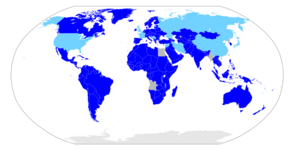
The most recent agreement, the Chemical Weapons Convention, outlaws the production, storage, and use of chemical weapons. It is managed by the Organisation for the Prohibition of Chemical Weapons (OPCW).



